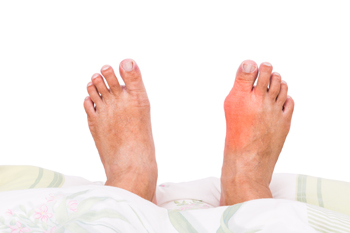
 The largest joint in the big toe is referred to as the metatarsophalangeal (MTP) joint. The MTP joint helps to balance the body’s weight while performing daily activities. A bunion is a bony protrusion that is considered to be a deformity that forms at this specific joint. It can develop from genetic factors, or from wearing shoes that do not have adequate room for the toes to move freely in. It may cause the second and third toe to overlap, and larger shoes may need to be worn. In larger bunions, a callus may form on top of the toe, and this is generally a result of excess friction that is caused by the shoe. Mild relief may be found when a protective pad is worn over the bunion. If you have developed this condition, it is best that you speak with a podiatrist who may suggest surgery for permanent removal.
The largest joint in the big toe is referred to as the metatarsophalangeal (MTP) joint. The MTP joint helps to balance the body’s weight while performing daily activities. A bunion is a bony protrusion that is considered to be a deformity that forms at this specific joint. It can develop from genetic factors, or from wearing shoes that do not have adequate room for the toes to move freely in. It may cause the second and third toe to overlap, and larger shoes may need to be worn. In larger bunions, a callus may form on top of the toe, and this is generally a result of excess friction that is caused by the shoe. Mild relief may be found when a protective pad is worn over the bunion. If you have developed this condition, it is best that you speak with a podiatrist who may suggest surgery for permanent removal.
If you are suffering from bunions, contact Dr. Thomas Tran of Southwestern Foot & Ankle Associates, P.C.. Our doctor can provide the care you need to keep you pain-free and on your feet.
What Is a Bunion?
A bunion is formed of swollen tissue or an enlargement of boney growth, usually located at the base joint of the toe that connects to the foot. The swelling occurs due to the bones in the big toe shifting inward, which impacts the other toes of the foot. This causes the area around the base of the big toe to become inflamed and painful.
Why Do Bunions Form?
Genetics – Susceptibility to bunions are often hereditary
Stress on the feet – Poorly fitted and uncomfortable footwear that places stress on feet, such as heels, can worsen existing bunions
How Are Bunions Diagnosed?
Doctors often perform two tests – blood tests and x-rays – when trying to diagnose bunions, especially in the early stages of development. Blood tests help determine if the foot pain is being caused by something else, such as arthritis, while x-rays provide a clear picture of your bone structure to your doctor.
How Are Bunions Treated?
If you have any questions, please feel free to contact our office located in Frisco, TX . We offer the newest diagnostic and treatment technologies for all your foot care needs.
Copyright © Southwestern Foot and Ankle Associates, P.C. | Site Map | Nondiscimination | Design by: Podiatry Content Connection